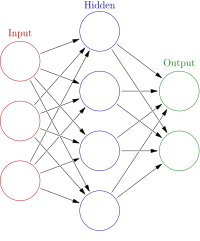
Photo from wikipedia
Low earth orbit (LEO) satellites promise to be a source of innovation in wireless communication and their physical layer security deserves attention. However, many physical layer security techniques are hampered… Click to show full abstract
Low earth orbit (LEO) satellites promise to be a source of innovation in wireless communication and their physical layer security deserves attention. However, many physical layer security techniques are hampered by excessive power consumption and high latency when used for LEO satellites. This letter proposes an energy-efficiency radio frequency fingerprinting identification (RFFI) method for LEO satellite communication systems based on spiking neural networks (SNN). In addition, we investigate a channel-independent RFF feature transformation and data augmentation to enhance system robustness. Numerical results show that our proposed model can yield identification accuracy up to 95.26% at a signal-to-noise ratio (SNR) of 25dB on orthogonal frequency division multiplexing (OFDM) signals, and reduces power consumption by 63.3% compared to existing models of comparable accuracy on FPGA.
Journal Title: IEEE Wireless Communications Letters
Year Published: 2023
Link to full text (if available)
Share on Social Media: Sign Up to like & get
recommendations!